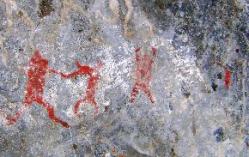09 JANVIER
INDI-UNI : ANTHROPOLOGY - ARCHAEOLOGY
INSCRIPTION 2012 COURS A DISTANCE
REGISTRATION 2012 ONLINE COURSES
PEROU –  Torongana - The president of the Cave Art Peruvian Association, Gori Echevarria reported the finding of cave paintings depicting humans, animals and geometric figures (circa 8-12,000 years old) in the province of Churcampa, located in the country's central Huancavelica region. Echevarria said six cave paintings were identified in a 20-meter stone wall in the last days which depict humans in hunting positions. Said “Quilcas”, which is the native name for this art form, are red, white and black and will be at least 8 to 12,000 years old, the archaeologist told Andina news agency. “This finding confirms the great cognitive development of ancient Peru and establishes a reference its pictorial tradition. Most important is the variation and extension of the motifs and scenes,” he said. The cave in which said paintings were found is located at some 3,200 meters above sea level in Torongana mountain.
Torongana - The president of the Cave Art Peruvian Association, Gori Echevarria reported the finding of cave paintings depicting humans, animals and geometric figures (circa 8-12,000 years old) in the province of Churcampa, located in the country's central Huancavelica region. Echevarria said six cave paintings were identified in a 20-meter stone wall in the last days which depict humans in hunting positions. Said “Quilcas”, which is the native name for this art form, are red, white and black and will be at least 8 to 12,000 years old, the archaeologist told Andina news agency. “This finding confirms the great cognitive development of ancient Peru and establishes a reference its pictorial tradition. Most important is the variation and extension of the motifs and scenes,” he said. The cave in which said paintings were found is located at some 3,200 meters above sea level in Torongana mountain.
http://www.andina.com.pe/Ingles/Noticia.aspx?Id=0wSJs39TTKo=
MYANMAR – Sri Ksetra - Excavation work at an archaeological site near Phayarma Pagoda at Sri Ksetra has uncovered a building unlike any other found at the ancient Pyu city, government officials say. Excavation on the site began in early September and has been led by the Department of Archaeology, National Museum and Library under the Ministry of Culture. The remains of a brick structure 14 metres long, 11m wide and 1.3m high were discovered near Phayarma pagoda at Sri Ksetra, located near Pyay in western Bago Region. The structure was found to hold 25 pots containing burial urns. It also had a well, 75 centimetres in diametre, and the baked floor of the structure is thought to have been regularly exposed to fire when the building was in use. However, little else is known about it at present. U Kyaw Oo Lwin, director general of the Department of Archaeology, said the objects excavated from the structure were unique to the site. The department is working to protect the building and making space for the public to learn about its significance, he said. Located in Hmaw Zar village, Sri Ksetra is about five miles (8 kilometres) southeast of Pyay. It flourished as a major Pyu settlement from the fourth to ninth centuries AD, pre-dating the rise of Bagan in the 11th century. U Kyaw Oo Lwin said the excavations aimed to improve understanding of the culture, lifestyle and architecture of Sri Ksetra relative to other Pyu settlements, such as Beikthano, Maingmaw and Hanlin. Meanwhile, the department has excavated the foundations of a pagoda in Sri Ksetra that is thought to pre-date the Pyu settlement. It has a similar structure to Pyu pagodas and buildings at Beikthano, while its religious edifices are similar to some found in India, U Kyaw Oo Lwin said.
http://www.mmtimes.com/2012/news/609/news60917.html
BELGIQUE –  Spy - L’Homme de Spy fait l’actualité grâce à la reconstitution hyperréaliste réalisée par les frères Kennis qui a été présentée hier à l’Institut des Sciences naturelles de Belgique et sera présenté dès ce samedi . De nombreux journaux consacre un article à sa reconstitution scientifique. Celle-ci fut possible grâce à la ré-étude complète des vestiges osseux de Spy qui fera bientôt l’objet d’une monographie et au suivi attentif des différentes étapes de la reconstitution par l’équipe de l’IRSNB et en particulier de Patrick Semal, paéonathropologue à l’IRSNB. Le résultat est époustouflant et nous offre pour la première fois une reconstitution 3D de Néandertalien transpirant d’humanité à l’image, par exemple, de ce que Benoît Clarys a pu réaliser précédemment dans ses illustrations.
Spy - L’Homme de Spy fait l’actualité grâce à la reconstitution hyperréaliste réalisée par les frères Kennis qui a été présentée hier à l’Institut des Sciences naturelles de Belgique et sera présenté dès ce samedi . De nombreux journaux consacre un article à sa reconstitution scientifique. Celle-ci fut possible grâce à la ré-étude complète des vestiges osseux de Spy qui fera bientôt l’objet d’une monographie et au suivi attentif des différentes étapes de la reconstitution par l’équipe de l’IRSNB et en particulier de Patrick Semal, paéonathropologue à l’IRSNB. Le résultat est époustouflant et nous offre pour la première fois une reconstitution 3D de Néandertalien transpirant d’humanité à l’image, par exemple, de ce que Benoît Clarys a pu réaliser précédemment dans ses illustrations.
L’Homme de Spy est un Homme de Néandertal. Il n’est ni le premier squelette mis au jour, ni le plus complet. Sa renommée, il la doit aux circonstances de sa découverte, en 1886 : pour la première fois, les archéologues disposent de preuves suffisantes pour faire admettre l’existence, et l’ancienneté, d’êtres humains différents des Hommes anatomiquement modernes. De récentes études ont permis d’affirmer qu’il s’agit en réalité non pas d’un, mais de trois individus : deux adultes et un enfant de moins de 2 ans. Ils ont vécu il y a environ 36 000 ans. Au moins un des trois a été enterré volontairement dans la grotte de Spy.
http://www.minesdespiennes.org/blog/2012/lhomme-de-spy-a-enfin-un-visage/
ROYAUME UNI –  Yarmouth - Demolition work has started on a historic jetty in Great Yarmouth after councillors decided it would cost too much to restore and maintain. The jetty was used by a victorious Lord Nelson upon his return to England after the Battle of Copenhagen in 1801. Margaret Gooch, of the Great Yarmouth Local history and Archaeology Society, said: "The jetty was very important to Yarmouth's history during the 16th Century when it was built. "It was important to the Royal Navy during the Napoleonic wars and used for victualing their ships which were moored in Yarmouth quite regularly. "I think the town should make much more of its heritage to attract more visitors to the town which would be in our economic interest. Now we've lost one more construction that was important to the town's history. We are very sorry to lose it."
Yarmouth - Demolition work has started on a historic jetty in Great Yarmouth after councillors decided it would cost too much to restore and maintain. The jetty was used by a victorious Lord Nelson upon his return to England after the Battle of Copenhagen in 1801. Margaret Gooch, of the Great Yarmouth Local history and Archaeology Society, said: "The jetty was very important to Yarmouth's history during the 16th Century when it was built. "It was important to the Royal Navy during the Napoleonic wars and used for victualing their ships which were moored in Yarmouth quite regularly. "I think the town should make much more of its heritage to attract more visitors to the town which would be in our economic interest. Now we've lost one more construction that was important to the town's history. We are very sorry to lose it."
http://www.bbc.co.uk/news/uk-england-norfolk-16469828